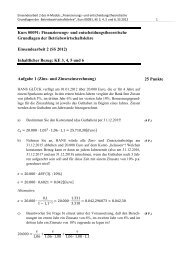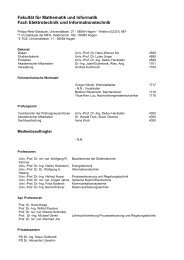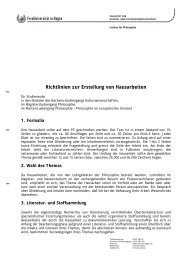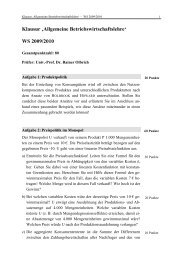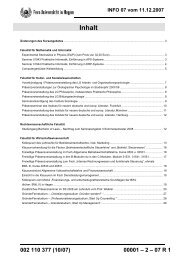An Invitation to Random Schr¨odinger operators - FernUniversität in ...
An Invitation to Random Schr¨odinger operators - FernUniversität in ...
An Invitation to Random Schr¨odinger operators - FernUniversität in ...
You also want an ePaper? Increase the reach of your titles
YUMPU automatically turns print PDFs into web optimized ePapers that Google loves.
16<br />
(A − z 1 ) −1 − (A − z 2 ) −1 = (z 1 − z 2 ) (A − z 1 ) −1 (A − z 2 ) −1 (3.17)<br />
and, if D(A) = D(B),<br />
= (z 1 − z 2 ) (A − z 2 ) −1 (A − z 1 ) −1 (3.18)<br />
(A − z) −1 − (B − z) −1 = (A − z) −1 (B − A) (B − z) −1 (3.19)<br />
For z ∈ C and M ⊂ C we def<strong>in</strong>e<br />
= (B − z) −1 (B − A) (A − z) −1 (3.20)<br />
dist(z, M) = <strong>in</strong>f{|z − ζ|; ζ ∈ M} (3.21)<br />
It is not hard <strong>to</strong> see that for any self adjo<strong>in</strong>t opera<strong>to</strong>r A and any z ∈ ρ(A) the<br />
opera<strong>to</strong>r norm ‖(A − z) −1 ‖ of the resolvent is given by<br />
‖(A − z) −1 ‖ =<br />
1<br />
dist(z, σ(A)) . (3.22)<br />
In particular, for a self adjo<strong>in</strong>t opera<strong>to</strong>r A and z ∈ C \ R<br />
‖(A − z) −1 ‖ ≤<br />
1<br />
Im z . (3.23)<br />
For the rest of this section we assume that the opera<strong>to</strong>r A is bounded. In this case,<br />
polynomials of the opera<strong>to</strong>r A can be def<strong>in</strong>ed straightforwardly<br />
A 2 ϕ = A ( A(ϕ) ) (3.24)<br />
(<br />
A 3 ϕ = A A ( A(Aϕ) )) etc. (3.25)<br />
More generally, if P is a complex valued polynomial <strong>in</strong> one real variable, P (λ) =<br />
∑ n<br />
j=0 a nλ j then<br />
It is a key observation that<br />
P (A) =<br />
n∑<br />
a n A j . (3.26)<br />
j=0<br />
‖P (A)‖ =<br />
sup<br />
λ∈σ(A)<br />
|P (λ)| (3.27)<br />
Let now f be a function <strong>in</strong> C ( σ(A) ) the complex-valued cont<strong>in</strong>uous functions on<br />
(the compact set) σ(A). The Weierstraß approximation theorem tells us, that on<br />
σ(A) the function f can be uniformly approximated by polynomials. Thus us<strong>in</strong>g<br />
(3.27) we can def<strong>in</strong>e the opera<strong>to</strong>r f(A) as a norm limit of polynomials P n (A).<br />
These opera<strong>to</strong>rs satisfy




